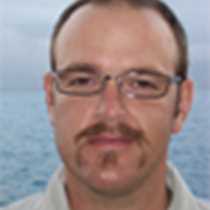Floreana Island
There are times in our lives when we try to make a connection with our past and the present and today was such a day. The sunrise welcomed us to a visit at Cormorant Point at Floreana Island and we made a pre-breakfast landing on a sparkling beach. This landing beach is interesting as it contains olivine crystals within the sand that were formed at a great depth within the earth before being exposed here along the coast and beach.
As we cross the small isthmus here we encounter a completely different beach, one that is formed by the erosion and digestion of small coral reefs by various fish species. This is a contrast in formation and origin as we see organic and inorganic beaches so close together. The white beach has hundreds of recently formed nests by the Pacific green sea turtle, as they arrived in the night to dig their nests and lay 30-60 eggs in their struggle to continue their path in life.
Contrasts are drastic here in Galápagos as species try to live in an environment that is always challenging. Along the path there is an abundance of endemic plants that show the diversity of Galápagos, including the Floreana daisy and scalesia, which is a marvelous representation of adaptive radiation as the 20-odd variations we find today have all descended from one representative. Flamingos completed our visit on this early outing as they gradually moved across a brackish pond trying to find their food in the shallows. We return to the ship to prepare for a short navigation and eventually Zodiac rides and snorkeling.
Mid-morning surprises us (once again I may add) with a Zodiac ride around a small satellite island of Floreana. Champion Islet holds a small population of the Floreana mockingbird, which is down to a population size in the hundreds due to predation of invasive species. We had various individuals moving around the coast searching for their daily subsistence. We will soon be able to repatriate the Floreana mockingbird back to the main island, restoring their historic range – conservation at its best.
Snorkeling is incredible as the warm water surrounds us. The deep water moving around the island provides a “playground” for the sea lions as they swim amongst the diversity of life found in these waters. Manta rays, small reef sharks, schools of fish, and seas stars are some of the highlights. As we return to the ship it is hard to believe that it is only mid-day.
In the afternoon the kayakers find their rhythm as they explore the coast of Post Office Bay. This area is famous for the checkered history of human behavior here. Among crazy dentists, self-proclaimed baronesses, and strange first colonists they have left us an interesting history of our human species’ behavior. After exploring a sea-lion colony that has many shore birds to be discovered among the sea lions, we make a landing at the famous “Post Office Bay” which holds a post barrel that history dates to the 1700’s. We are to leave our post cards here and we collect cards that need to be delivered by hand to their destinations. This honor system has been functioning since the whaling times here in Galápagos. Human history abounds as we try to understand this delicate balance between us and the environment that we live in. Dark rain clouds approach us as we board our home, National Geographic Endeavour so we can continue this unique adventure.




